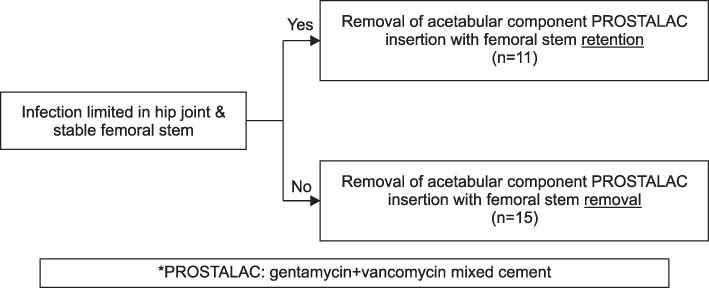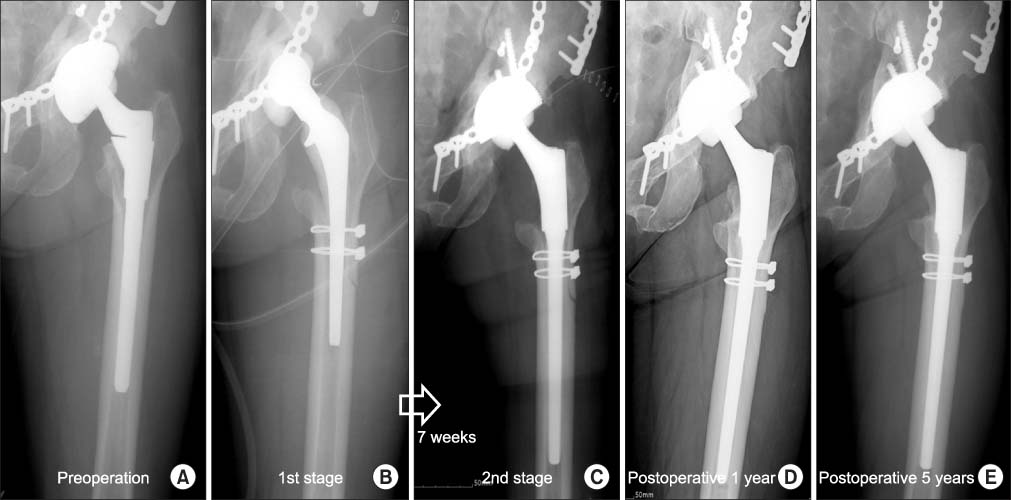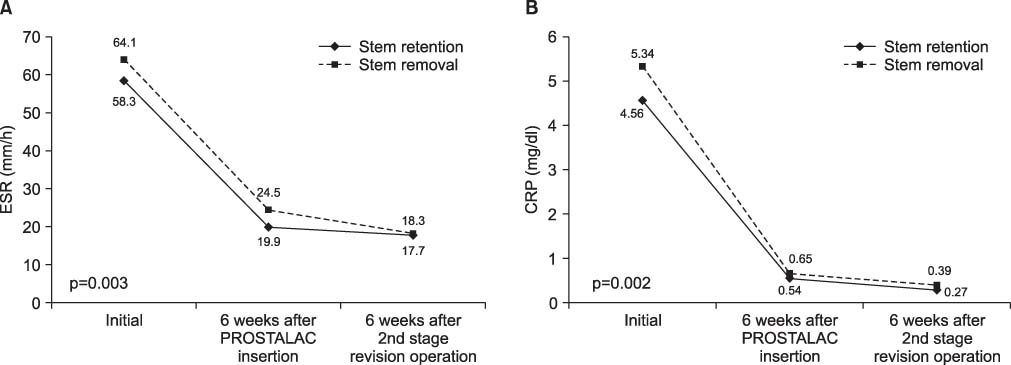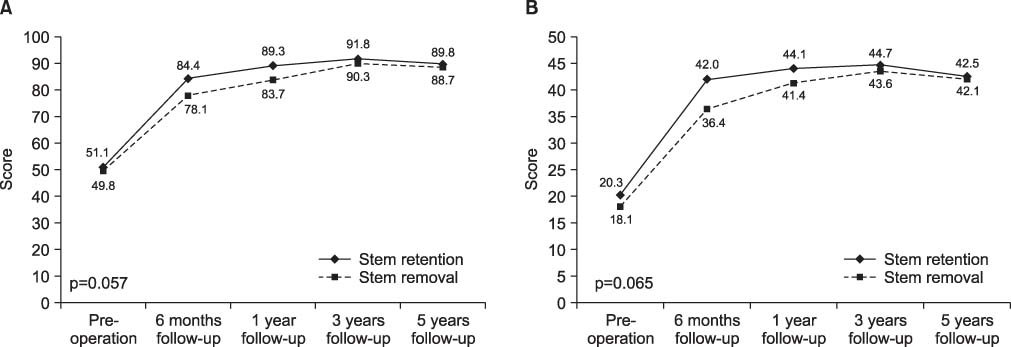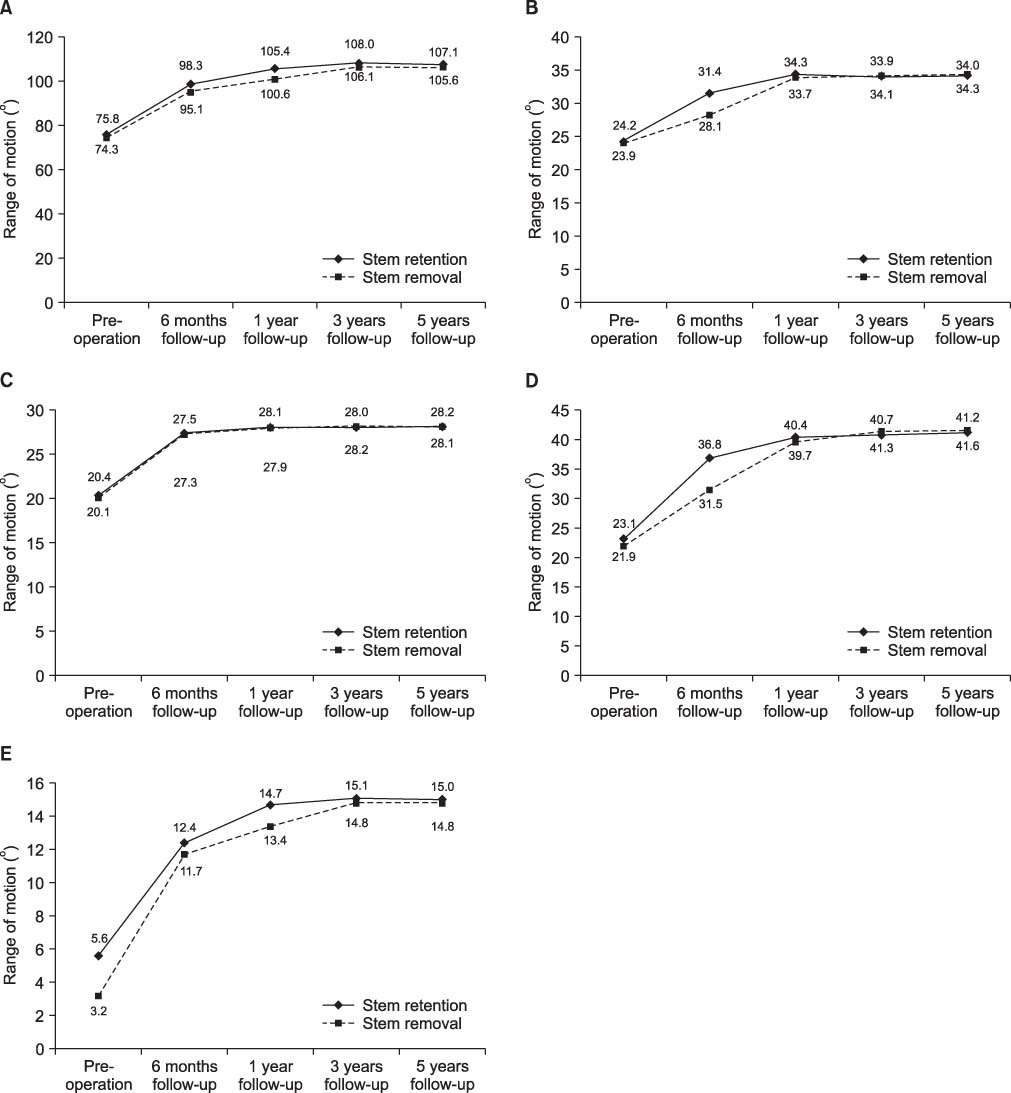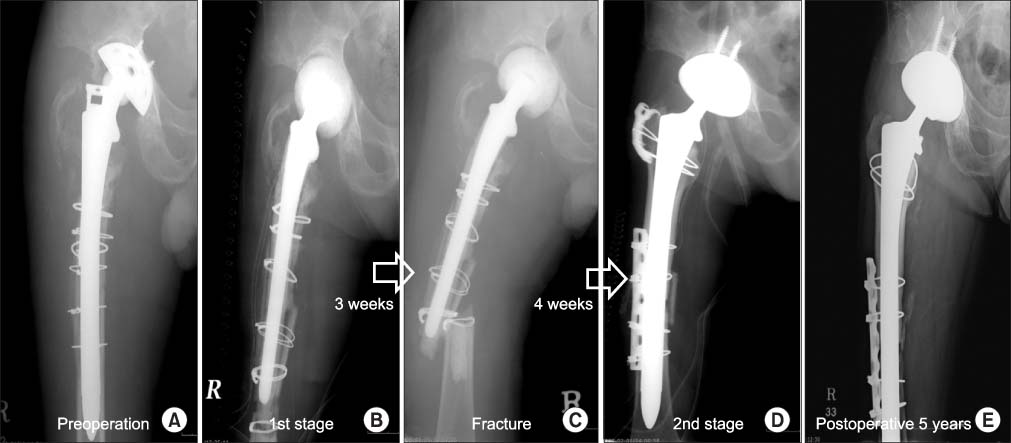J Korean Orthop Assoc.
2014 Oct;49(5):355-365. 10.4055/jkoa.2014.49.5.355.
Long-Term Clinical Outcome of Two Stage Revision Surgery for Infected Hip Arthroplasty Using Cement Spacer
- Affiliations
-
- 1Department of Orthopedic Surgery, Inha University School of Medicine, Incheon, Korea. zero-ti@hanmail.net
- KMID: 2185171
- DOI: http://doi.org/10.4055/jkoa.2014.49.5.355
Abstract
- PURPOSE
We retrospectively analyzed long-term clinical results after two-stage revision arthroplasty using an antibiotic-impregnated cement spacer for infected total hip arthroplasty.
MATERIALS AND METHODS
Twenty-six hips (group 1: cup exchanged, group 2: cup and stem exchanged) were enrolled in this study. The mean follow-up period was 7.4 years (5 to 11 years). We analyzed the laboratory findings, the time interval between antibiotic-impregnated cement spacer insertion and revision arthroplasty, Harris hip score, Oxford hip score, radiologic changes, and recurrence of infection.
RESULTS
Revision hip arthroplasty was performed at 7.5 weeks on average (group 1: 7.2 weeks, group 2: 7.7 weeks) after implant removal and cement spacer insertion. In group 1, Harris hip score was 51.1 points preoperatively, 84.4 points at six months, 89.3 points in at one year, 91.8 points at three years, and 89.8 points at five years. In group 2, the Harris hip score was 49.8 points preoperatively, 78.1 points at six months, 83.7 points at one year, 90.3 points at three years, and 88.7 points at five years. Recurrence of infection developed in one hip in each group.
CONCLUSION
Ninety-two percent of infected hips were eradicated with two-stage revision arthroplasty using an antibiotic-impregnated cement spacer for infected hip arthroplasty at minimum five-year follow-up. When the infection was limited to the hip joint and the stem was fixed well, two-stage revision with stem retained could be a good treatment option.
Keyword
MeSH Terms
Figure
Reference
-
1. Blom AW, Taylor AH, Pattison G, Whitehouse S, Bannister GC. Infection after total hip arthroplasty. The Avon experience. J Bone Joint Surg Br. 2003; 85:956–959.2. Bozic KJ, Ries MD. The impact of infection after total hip arthroplasty on hospital and surgeon resource utilization. J Bone Joint Surg Am. 2005; 87:1746–1751.
Article3. Hunter GA, Welsh RP, Cameron HU, Bailey WH. The results of revision of total hip arthroplasty. J Bone Joint Surg Br. 1979; 61:419–421.
Article4. Han HJ, You JM. Two stage exchange of infected total hip arthroplasty. J Korean Hip Soc. 1998; 10:127–133.5. Moon KH, Kang JS, Lee TJ, Jung JH. Two-stage revision surgery of the infected hip bipolar hemiarthroplasty using the PROSTALAC. J Korean Orthop Assoc. 2005; 40:442–448.
Article6. Park BJ, Cho HM, Sim JH, Choi HJ. Treatment of infected hip arthroplasty with antibiotic-impregnated calcium sulfate cement. J Korean Hip Soc. 2011; 23:310–317.
Article7. Sung YB, Lee EY, Ahn JK, et al. Antibiotic-loaded cement spacers for two-stage arthroplasties of infected hip joints for two-stage arthroplasties of infected hip joints. J Korean Hip Soc. 2000; 12:18–27.8. Sung YB, Oh JS. Staged revision of infected hip arthroplasty using an antibiotics-loaded intra-articular cement spacer with retention of the stem. J Korean Hip Soc. 2010; 22:66–72.
Article9. Lee YK, Lee KH, Nho JH, Ha YC, Koo KH. Retaining well-fixed cementless stem in the treatment of infected hip arthroplasty. Acta Orthop. 2013; 84:260–264.
Article10. Yang JW, Koo KH, Cho SH, et al. Two-stage arthroplasty for infected total hip arthroplasty utilizing a cement spacer impregnated with triple antibiotics (Vancomycin, Cephalosporin, Gentamicin). J Korean Hip Soc. 1999; 11:86–93.11. Masri BA, Panagiotopoulos KP, Greidanus NV, Garbuz DS, Duncan CP. Cementless two-stage exchange arthroplasty for infection after total hip arthroplasty. J Arthroplasty. 2007; 22:72–78.
Article12. White J, Kelly M, Dunsmuir R. C-reactive protein level after total hip and total knee replacement. J Bone Joint Surg Br. 1998; 80:909–911.
Article13. Hart WJ, Jones RS. Two-stage revision of infected total knee replacements using articulating cement spacers and short-term antibiotic therapy. J Bone Joint Surg Br. 2006; 88:1011–1015.
Article14. Phillips JE, Crane TP, Noy M, Elliott TS, Grimer RJ. The incidence of deep prosthetic infections in a specialist orthopaedic hospital: a 15-year prospective survey. J Bone Joint Surg Br. 2006; 88:943–948.15. Esenwein SA, Robert K, Kollig E, Ambacher T, Kutscha-Lissberg F, Muhr G. Long-term results after resection arthroplasty according to Girdlestone for treatment of persisting infections of the hip joint. Chirurg. 2001; 72:1336–1343.16. Grauer JD, Amstutz HC, O'Carroll PF, Dorey FJ. Resection arthroplasty of the hip. J Bone Joint Surg Am. 1989; 71:669–678.
Article17. Buchholz HW, Elson RA, Engelbrecht E, Lodenkämper H, Röttger J, Siegel A. Management of deep infection of total hip replacement. J Bone Joint Surg Br. 1981; 63:342–353.
Article18. Raut VV, Siney PD, Wroblewski BM. One-stage revision of infected total hip replacements with discharging sinuses. J Bone Joint Surg Br. 1994; 76:721–724.
Article19. Winkler H, Stoiber A, Kaudela K, Winter F, Menschik F. One stage uncemented revision of infected total hip replacement using cancellous allograft bone impregnated with antibiotics. J Bone Joint Surg Br. 2008; 90:1580–1584.
Article20. Takahira N, Itoman M, Higashi K, Uchiyama K, Miyabe M, Naruse K. Treatment outcome of two-stage revision total hip arthroplasty for infected hip arthroplasty using antibiotic-impregnated cement spacer. J Orthop Sci. 2003; 8:26–31.
Article21. Biring GS, Kostamo T, Garbuz DS, Masri BA, Duncan CP. Two-stage revision arthroplasty of the hip for infection using an interim articulated Prostalac hip spacer: a 10- to 15-year follow-up study. J Bone Joint Surg Br. 2009; 91:1431–1437.22. Hsieh PH, Shih CH, Chang YH, Lee MS, Shih HN, Yang WE. Two-stage revision hip arthroplasty for infection: comparison between the interim use of antibiotic-loaded cement beads and a spacer prosthesis. J Bone Joint Surg Am. 2004; 86:1989–1997.23. Haddad FS, Muirhead-Allwood SK, Manktelow AR, Bacarese-Hamilton I. Two-stage uncemented revision hip arthroplasty for infection. J Bone Joint Surg Br. 2000; 82:689–694.
Article24. Okoro T, Lemmey AB, Maddison P, Andrew JG. An appraisal of rehabilitation regimes used for improving functional outcome after total hip replacement surgery. Sports Med Arthrosc Rehabil Ther Technol. 2012; 4:5.
Article25. Wylde V, Livesey C, Blom AW. Restriction in participation in leisure activities after joint replacement: an exploratory study. Age Ageing. 2012; 41:246–249.
Article
- Full Text Links
- Actions
-
Cited
- CITED
-
- Close
- Share
- Similar articles
-
- Treatment of Infected uncemented Total Hip Arthroplasty: Two-stage revision procedure by preserving well-fixed femoral components in four cases
- Reducing Dislocations of Antibiotic Hip Spacers via Hybrid Cement-screw Constrained Liner Fixation: A Case Series
- Staged Revision of Infected-hip Arthroplasty Using an Antibiotics-loaded Intra-articular Cement Spacer: Impact on Cemented and Cementless Stem Retention
- Staged Revision of Infected Hip Arthroplasty Using an Antibiotics-Loaded Intra-Articular Cement Spacer with Retention of the Stem
- Two-Stage Revision Using a Modified Articulating Spacer in Infected Total Knee Arthroplasty

